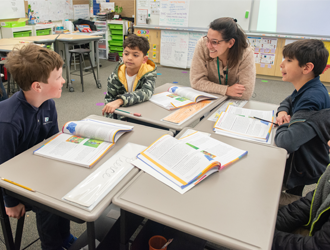

The Power of Choice: Creating Student Autonomy

How do we foster autonomy within our students? Offering choice and encouraging decision making in the classroom leads students to choose what really matters to them. When interests become more clear, learning takes on an active and empowering role. As students step into their roles of learner centered practice, they are likely to feel more engaged and comfortable to take risks in a classroom environment.
What is Student Autonomy?
When we create opportunities for students to take initiative— we underscore their personal autonomy. Personal autonomy is linked to the competence of assertiveness: the ability to stand for one’s ideas without hurting or negating others, to seek help, to persevere with a challenging task, and to recognize one’s individual self as separate from the environment, circumstances or conditions one is in (Fly Five).
When age appropriate choices are offered, children are more likely to engage in their academic and social environments (McCombs, B. 2010). Research shows that motivation and self-determination are linked– which encourages students to take ownership of their learning. (McCombs, B.) Student autonomy can show up a number of ways in the classroom:
- Practicing academic choice in a learning environment
- Seeking out topics of interest that support independent learning
- Empowering students to be vocal about their questions and learning
With practice, students will become more comfortable making decisions in a classroom environment on their own, even as challenges arise. Encouraging children to tie their personal interests into their learning activities will make them more likely to participate and apply meaningful choices in an academic setting. Research shows that when students are more interested in learning material, their intrinsic motivation, or natural motivation and satisfaction is engaged. (Schwartz, K. 2019). Providing choice can also stimulate their creativity and inform students of what really matters to them in and out of school communities.

Why Student Autonomy Matters
With autonomous choice, comes independence— but it won’t happen overnight. Fostering student autonomy is worth the work because it is beneficial in a variety of ways. Setting clear performance expectations gives children a clearer understanding of goals and expectations from their work. (McCombs, B.) If they are aware of how they will be graded as well as where additional learning support exists within school communities, it will help sharpen other social and emotional learning (SEL) competencies, like responsibility and assertiveness.
When there is empowered decision making in an academic setting, students are more likely to make responsible choices in a low-risk environment. Studies also show that students who demonstrate autonomy take ownership of their learning and become well-rounded members of society (Bandura, 1993). Student autonomy can create independent thinkers, who aren’t afraid to ask for help. Although independent thinking is encouraged, fostering autonomy allows for less student isolation, promotes positive growth and gives learners at any age a voice to develop personal and social responsibility. (McCombs, B. 2010)

What Does Autonomy Look and Sound Like?
Autonomous students are being cultivated every day through choice, challenge, collaboration and control. (Schwartz, K. 2019). Although choice may seem unwieldy for larger classrooms, remember that teachers create the rules for which the options are given. Oftentimes choice shows students that there is a mutual trust between learners and teachers. Every choice that students make can and should start small. With teachers providing guidance and support within a variety of choices, students can choose to work together or alone, create inquiry-based learning opportunities and offer a multitude of ways to show their knowledge.
As children become more comfortable with choice, they will form the ability to express strong emotions and opinions effectively, and continue to guide their own learning through a variety of decisions. Other ways autonomy can look and sound in the classroom include:
- Practicing their ability to seek and ask for help. The competency of assertiveness is encouraged when students are given the opportunity to speak up and express their needs.
- Students are more likely to show openness and honesty when a mutual trust is set between teachers and students.
- Exploring their capacity to persist through challenging events also encourages students to demonstrate action steps in fulfilling their responsibilities.
Fostering the power of choice in the classroom can lead to more active and longer lasting student autonomy. (Ferlazzo, L. 2015). Through empowering learners to take their education into their own hands, it improves motivation and learning, while allowing students to create their own positive school environment.
Sources:
Bandura, A. (1993). Perceived self-efficacy in cognitive development and functioning. Educational Psychologist, 28(2), 117-148.
McCombs, B. (2010) Developing Responsible and Autonomous Learners: A Key to Motivating Students. American Psychological
Schwartz, K. (2019) Four Research-Based Strategies to Ignite Intrinsic Motivation In Students. KQED.https://www.kqed.org/mindshift/53426/four-research-based-strategies-to-ignite-intrinsic-motivation-in-students
Ferlazzo, L. (2015) Strategies for Helping Students Motivate Themselves. Edutopia. https://www.edutopia.org/blog/strategies-helping-students-motivate-themselves-larry-ferlazzo








